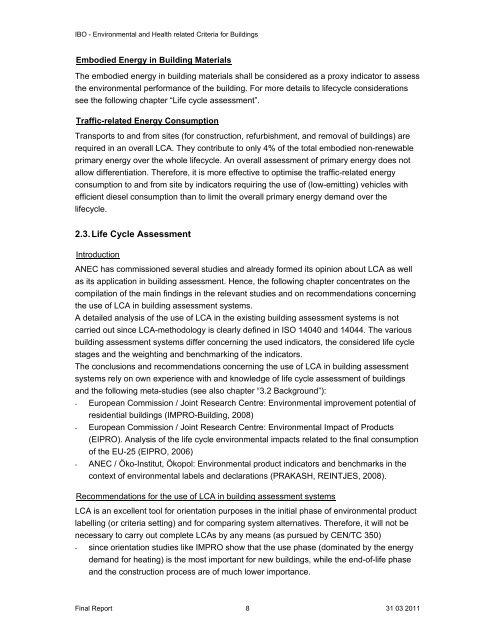Environmental and health related criteria for buildings - ANEC
Environmental and health related criteria for buildings - ANEC
Environmental and health related criteria for buildings - ANEC
Create successful ePaper yourself
Turn your PDF publications into a flip-book with our unique Google optimized e-Paper software.
IBO - <strong>Environmental</strong> <strong>and</strong> Health <strong>related</strong> Criteria <strong>for</strong> Buildings<br />
Embodied Energy in Building Materials<br />
The embodied energy in building materials shall be considered as a proxy indicator to assess<br />
the environmental per<strong>for</strong>mance of the building. For more details to lifecycle considerations<br />
see the following chapter “Life cycle assessment”.<br />
Traffic-<strong>related</strong> Energy Consumption<br />
Transports to <strong>and</strong> from sites (<strong>for</strong> construction, refurbishment, <strong>and</strong> removal of <strong>buildings</strong>) are<br />
required in an overall LCA. They contribute to only 4% of the total embodied non-renewable<br />
primary energy over the whole lifecycle. An overall assessment of primary energy does not<br />
allow differentiation. There<strong>for</strong>e, it is more effective to optimise the traffic-<strong>related</strong> energy<br />
consumption to <strong>and</strong> from site by indicators requiring the use of (low-emitting) vehicles with<br />
efficient diesel consumption than to limit the overall primary energy dem<strong>and</strong> over the<br />
lifecycle.<br />
2.3. Life Cycle Assessment<br />
Introduction<br />
<strong>ANEC</strong> has commissioned several studies <strong>and</strong> already <strong>for</strong>med its opinion about LCA as well<br />
as its application in building assessment. Hence, the following chapter concentrates on the<br />
compilation of the main findings in the relevant studies <strong>and</strong> on recommendations concerning<br />
the use of LCA in building assessment systems.<br />
A detailed analysis of the use of LCA in the existing building assessment systems is not<br />
carried out since LCA-methodology is clearly defined in ISO 14040 <strong>and</strong> 14044. The various<br />
building assessment systems differ concerning the used indicators, the considered life cycle<br />
stages <strong>and</strong> the weighting <strong>and</strong> benchmarking of the indicators.<br />
The conclusions <strong>and</strong> recommendations concerning the use of LCA in building assessment<br />
systems rely on own experience with <strong>and</strong> knowledge of life cycle assessment of <strong>buildings</strong><br />
<strong>and</strong> the following meta-studies (see also chapter “3.2 Background”):<br />
- European Commission / Joint Research Centre: <strong>Environmental</strong> improvement potential of<br />
residential <strong>buildings</strong> (IMPRO-Building, 2008)<br />
- European Commission / Joint Research Centre: <strong>Environmental</strong> Impact of Products<br />
(EIPRO). Analysis of the life cycle environmental impacts <strong>related</strong> to the final consumption<br />
of the EU-25 (EIPRO, 2006)<br />
- <strong>ANEC</strong> / Öko-Institut, Ökopol: <strong>Environmental</strong> product indicators <strong>and</strong> benchmarks in the<br />
context of environmental labels <strong>and</strong> declarations (PRAKASH, REINTJES, 2008).<br />
Recommendations <strong>for</strong> the use of LCA in building assessment systems<br />
LCA is an excellent tool <strong>for</strong> orientation purposes in the initial phase of environmental product<br />
labelling (or <strong>criteria</strong> setting) <strong>and</strong> <strong>for</strong> comparing system alternatives. There<strong>for</strong>e, it will not be<br />
necessary to carry out complete LCAs by any means (as pursued by CEN/TC 350)<br />
- since orientation studies like IMPRO show that the use phase (dominated by the energy<br />
dem<strong>and</strong> <strong>for</strong> heating) is the most important <strong>for</strong> new <strong>buildings</strong>, while the end-of-life phase<br />
<strong>and</strong> the construction process are of much lower importance.<br />
Final Report 8 31 03 2011
















